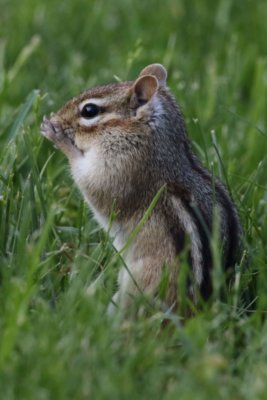Animal personality diversity crucial to the future
Each of Vermont’s tens of thousands of native species fills an ecological niche, influencing its environment and the species around it in different ways. While an important component of managing for healthy, biologically-diverse forests includes managing for species diversity (different species of wildlife, trees and plants), there are also differences in behavior between individuals of the same species.
The emergent study of intraspecific behavioral variation — also known as animal personality — has illuminated the behavioral diversity within individual species. Studies of animal personality focus largely on five traits: boldness/shyness, aggressiveness, activity, exploratory behavior and sociability. Across a growing body of scientific literature, species from birds and grizzly bears to worms and salamanders exhibit a range of personalities which influence the way that they forage, reproduce, rear their young and more.

Both bold and shy chipmunks are important in the forest for a variety of plants and animals.
A recent study by researchers from the University of Maine, detailed in The New York Times, examined animal personality by looking at synzoochory, the dispersal of seeds by seed-caching animals. Synzoochory is thought to be a mutualistic (mutually beneficial) relationship between trees and the animals which cache their seeds. This study found that some deer mice and red-backed voles were more mutualistic — more likely to spread and cache viable acorns, while others were more antagonistic — more likely to consume acorns or to cache them in places where they would be unable to sprout.
Research into animal personality has given rise to another fascinating concept: the keystone individual. Many of us are aware of the idea of a keystone species: a species, like beaver, whose behavior supports an array of habitats and natural processes. A keystone individual is a single animal whose behavior is disproportionately valuable to the ecosystem that it inhabits, to other species, or to groups of their own species. For instance, the mice and voles which were more likely to cache viable acorns could be called keystone individuals because they distributed and planted oaks across the forest, thus serving an invaluable ecological role. In social animals from birds to fish to spiders, keystone individuals have also been observed to change the personality and the behavior of colonies, flocks and schools of their own species.
While some animal personality traits may seem to be “better” than others, it is suspected that a behavioral diversity exists because different personality traits are beneficial at different times and in different situations, and because there are trade-offs associated with different traits. For example, a bolder deer may be more successful at eating backyard apples — a highly-valuable food resource — but more likely to be killed by a hunter. A shyer deer may be better at avoiding predators but less successful at mating and foraging at times when boldness is necessary.
Biodiversity is key to forest resilience and adaptability, providing different pathways forward as ecosystems and species face both the harmful legacies of the past and an uncertain future. Researchers now suggest that behavioral diversity is important for the same reason: that a diversity of personalities affords a species more ways to respond to a changed and changing world.
In our relatively young and simple forests, we have skewed animal personalities towards certain traits which are adaptive under these conditions. To encourage behavioral diversity, we need to invoke many of the same practices that we also use for a variety of other objectives: from providing habitat for declining songbirds to improving the climate resilience of our forests. Managing forests to be more diverse and complex, with different species of trees, different sizes and ages of trees, some big old trees and lots of dead wood on the forest floor will help encourage a diversity of animal personalities.
We also need to encourage landscape-level diversity: a landscape which is a connected mosaic of forests of different ages and in different stages of development and which are managed in different ways. Managing for habitats which may be underrepresented across our landscape — such as early successional forest — is important, as is encouraging some areas of unmanaged forest.
Animal personality is yet another example of the many intricacies of forest communities and another testament to the importance of managing them thoughtfully. As is the case with so many things, diversity is crucial both for protecting what we have and for moving into the future.
(Ethan Tapper is the Chittenden County Forester for the Vermont Department of Forests, Parks and Recreation. See what he’s been up to, check out his YouTube channel, sign up for his eNews and read articles he’s written.)

